Bali is an exotic island in Indonesia that holds incredible allure for travelers from around the world. Beyond its natural beauty, Bali is also rich in captivating culture, traditions, and history. In this article, we will explore three essential aspects that make Bali so special: culture, traditions.
Varieties of Culture and Traditions on the Island of Bali:
1.Trunyan Village Funerals
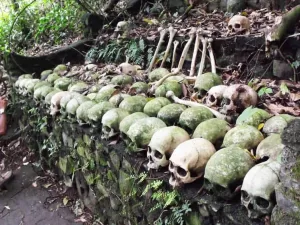
In Trunyan Village, Bali, there exists a unique tradition related to funerals. When someone passes away, their body is placed beneath the Menyan tree without burial. These bodies are only enclosed with bamboo to prevent them from being scavenged by wild animals. Surprisingly, these bodies do not emit a foul odor and eventually leave only skeletons. These bones are then placed in a special burial site, making this tradition one of a kind in Indonesia and a tourist attraction on the island of Bali.
2.Mekare-Kare Tradition

The Mekare-Kare tradition, also known as pandanus war, is only performed in Tenganan Village, Karangasem. In this tradition, two individuals face each other, holding a bunch of thorny pandanus leaves as weapons. This is an homage to the God of War or Lord Indra. Tenganan Village is one of the Bali Aga villages that preserve this tradition, making it a tourist attraction in Bali.
3.Omed-Omedan Tradition

The Omed-Omedan tradition is a ritual performed in the heart of Denpasar once a year, following Nyepi Day. This tradition involves unmarried young men and women, aged at least 13 years, pulling and sometimes even kissing each other. It is considered crucial to ward off misfortunes and has become a tourist attraction after Nyepi Day in Bali.
4.Mekotek Ritual Tradition
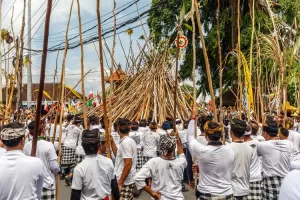
Mekotek can only be found in Munggu Village, Badung. It is typically held every six months during the celebration of Kuningan Day. The purpose is to drive away diseases and seek safety. This tradition involves wooden sticks arranged in cone formations, producing the distinct “tek, tek” sound when the sticks collide. It is one of the unique traditions still alive in Bali.
5.Gebug Ende Seraya
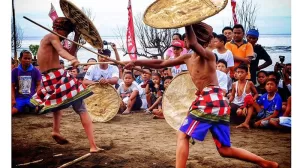
Gebug Ende Seraya, also known as rattan war, is a tradition held in Seraya Village, Karangasem. In this tradition, two men face each other and attack with rattan sticks while holding a shield to fend off their opponent’s strikes. The goal is to invoke rain and is usually held during the dry season in October-November each year.
6.Mesbes Bangke Tradition

In Banjar Buruan, Tampak Siring, Gianyar, there is an extreme tradition involving the mutilation of corpses before cremation. This tradition only applies to private ngaben ceremonies and is considered a unique cultural heritage in Gianyar, Bali.
7.Makepung Tradition

Makepung is a buffalo race held in the Jembrana regency. In this tradition, buffaloes controlled by jockeys race to either shorten or lengthen the distance between two pairs of buffaloes. It is an annual attraction involving groups of farmers in Jembrana.
8.Megibung Tradition in Karangasem

Megibung is a communal dining tradition where community members or families come together to share a meal. This typically occurs in a lively and joyful atmosphere. The prepared food often consists of traditional Balinese dishes like rice, side dishes, vegetables, and other local specialties. Megibung is a significant symbol of fraternity and togetherness in Balinese culture. It fosters stronger bonds among family, friends, and neighbors and builds solidarity within the community.
Megibung emphasizes that no one is left out or neglected. All community or family members, regardless of their social or economic status, are invited to partake in this communal meal. Although Megibung is about sharing a meal, sometimes there are ritualistic or traditional elements that add deeper meaning to the event. This may involve the performance of religious ceremonies or paying homage to ancestors. Megibung reflects the philosophy of balance and harmony in Balinese culture, emphasizing the importance of coexisting harmoniously with nature, fellow humans, and ancestral spirits.
Apart from being a family affair, Megibung can also serve as a social event involving a broader community. It is often used as a means to raise funds for social or religious activities.The Megibung tradition significantly enhances solidarity within the community. It provides an opportunity to converse, share stories, and strengthen existing social relationships.
9.Melasti Ceremony
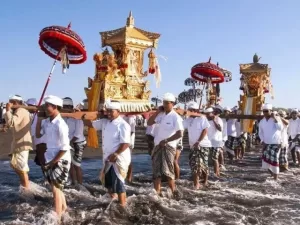
The Melasti Ceremony is a significant ritual in Balinese Hindu tradition, performed as a purification preparation before Nyepi Day, the Balinese New Year, or the Saka calendar New Year. The ceremony aims to spiritually cleanse and purify oneself through a ritual cleansing at the beach. Melasti ceremonies are usually conducted a few days before Nyepi Day and take place once a year as part of the Nyepi festivities in Bali. Melasti involves the process of cleansing and purifying everything by bringing sacred objects to a water source.
10.Ogoh-Ogoh Parade

The Ogoh-Ogoh Parade is one of the most vibrant and spectacular parts of the Nyepi Day celebrations in Bali, Indonesia. This parade typically takes place on the night before Nyepi Day, also known as “Day of Noise” or “Ngerupuk.” The Ogoh-Ogoh Parade is a spectacular celebration that involves the local community in the creation and display of giant effigies called “Ogoh-Ogoh.”
11.Nyepi Day

Nyepi Day, also known as “Saka New Year” or “Caka New Year,” is one of the most significant and unique celebrations in Balinese Hinduism. Nyepi Day marks the conclusion of the Saka New Year celebrations, which falls in March or April each year, according to the Saka calendar, different from the more commonly used Gregorian calendar. Nyepi Day is a profoundly sacred and peaceful moment in Bali. It is a time when the Balinese people reflect on spiritual values and maintain balance in their lives. Furthermore, Nyepi demonstrates the strength of Hindu traditions and culture in Balinese society, deeply rooted in their daily lives for centuries.
12.Ngaben Ceremony

The Ngaben Ceremony is a traditional cremation ceremony performed by the Hindu community in Bali, Indonesia. This ceremony holds profound meaning in Balinese Hindu culture, as it is believed to assist the departed soul in transitioning to the afterlife and beginning a new reincarnation cycle.
The Ngaben Ceremony is not only a funeral rite but also an expression of Bali’s Hindu belief in the cycle of life, death, and reincarnation. It is also a significant moment for strengthening family and community bonds, as many people attend to provide support and pay their respects to the deceased. The aim is to return the elements of the body to the universe and purify the departing soul.
13.Mejejaitan Ceremony
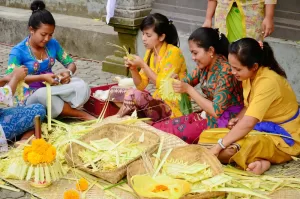
The Mejejaitan Ceremony is a deep-rooted ritual in Balinese Hinduism, aiming to cleanse and purify individuals from negative influences or spiritual illnesses that may be caused by malevolent spirits or negative energies. The ceremonial process involves several stages closely supervised by a priest or ceremony leader known as a “Pedanda.” Before the main ceremony begins, the individuals to be purified undergo preparatory rituals, including fasting, reciting mantras, and avoiding taboo activities.
During the Mejejaitan ceremony, holy water known as “tirta” is drawn from sacred sources to cleanse the individuals to be purified. This holy water is believed to possess powerful spiritual qualities for purifying the soul and body from negative influences. The ritual of pouring or bathing with holy water is accompanied by mantras recited by the Pedanda. Throughout the ceremony, the Pedanda also uses flowers, incense, and other offerings to invoke purity and protection from malevolent entities and to drive away negative spirits. Some Mejejaitan ceremonies also involve the symbolic use of traditional weapons like keris to symbolize protection and the strength granted by the Hindu gods of Bali.
As the ceremony progresses, the purified individuals often feel a sense of relief and calmness as the negative energies disturbing their spiritual and physical balance gradually dissipate. The Mejejaitan ceremony also involves family and friends as moral and spiritual support. Once completed, the purified individuals are expected to lead a better and more balanced life, maintaining physical and spiritual cleanliness. Aside from being a healing process, this ceremony strengthens the connection between individuals and the Hindu gods of Bali, promoting harmony within a society heavily influenced by these spiritual values.
Conclusion
All of these traditions add to the cultural richness of the island of Bali and serve as attractions for travelers seeking to experience Bali’s uniqueness. Bali is the perfect destination to explore its rich culture, traditions, and history. From mesmerizing performing arts to strong traditions and unforgettable natural beauty, Bali has it all. It is a place where you can find incredible natural beauty and deep insights into a diverse and rich culture. So, do not hesitate to make Bali your next travel destination.
Do not miss the opportunity to explore the beauty of Bali’s culture and traditions with BaliEthnik! Join us on an unforgettable adventure on the Island of Bali. Experience its exotic charm, enjoy its cultural wealth, and witness its natural beauty. Plan your trip now and create unforgettable memories with us. Discover Bali with BaliEthnik today!

